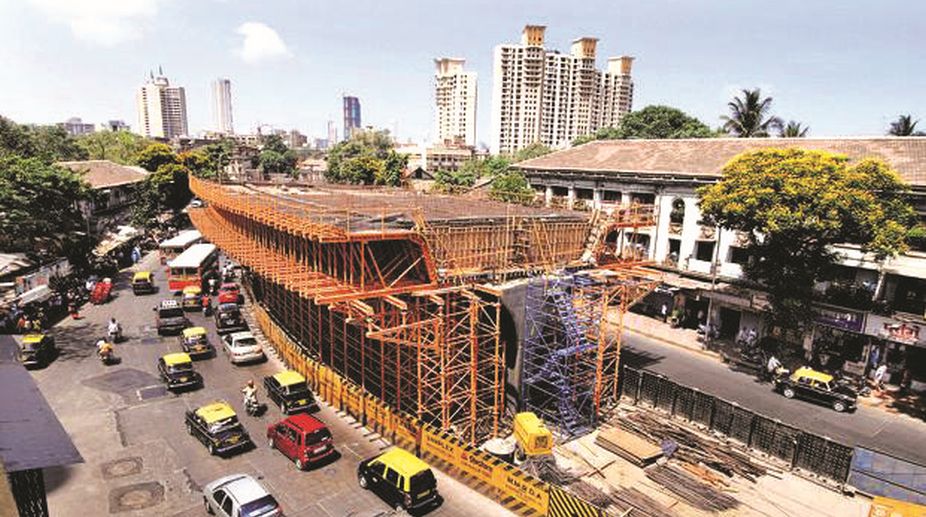Nuke energy critical for India’s ‘Net Zero’ goal: Jitendra Singh
The Union minister for science & technology highlighted the Union Budget 2024-25’s vision for India’s nuclear power expansion that sets a target of achieving 100 GW by 2047.
A recent consultation in Ahmedabad reinforced the scale of need for investment in urban infrastructure. But the big question, notes Rajesh Tandon, is whether Indian cities are ready and able to utilise such large investments.

Representational Image.
Rapidly urbanising India is a fact. Already around 40 percent of Indians live in urban areas, though the real numbers may be somewhat higher. More than half of India’s population, nearly 800 million, would be living in urban areas by 2030. It is also a fact that nearly two-third of India’s GDP, and three-fourth of jobs, are provided by urban India. The future seems to indicate continuation of that trend.
Prime Minister Narendra Modi’s dream of New India by 2022 can only be realised if urban infrastructure in India’s cities are developed. It is precisely with this in mind that the Union government has initiated a number of national programmes for urban development.
Advertisement
SMART City initiative identified 99 such cities around the country, and an investment of Rs 100 crore is being provided to each of them. Likewise, AMRUT scheme focuses on 500 smaller cities and towns around the country with separate budgetary provisions. Several other national programmes ~ like Swachh Bharat Mission-Urban (SBM-U) and Housing for All (HFA) ~ have also committed funds for urban areas.
Advertisement
The requirements for improving urban infrastructure in the country are so huge that much additional investment is necessary. It is estimated that an investment of nearly 600 billion dollars in urban infrastructure would be required over the next five years.
This is a huge amount, and clearly public investments will not suffice. Hence, the Union government is aggressively promoting policies for attracting private investment for urban infrastructure, both from within the country and internationally.
In this context, a recent consultation was organised in Ahmedabad, jointly by Ministry of Finance and Ministry of External Affairs, to prepare the ground for attracting greater international financial investment towards urban infrastructure. Recommendations from this consultation are expected to feed into the forthcoming Board of Governors Annual Meetings of Asian Infrastructure Investment Bank (AIIB) in Mumbai in end June.
The consultation in Ahmedabad reinforced the scale of need for investment in urban infrastructure. Some pilot innovations in mobilising new investments being carried out in various cities were shared. It was reported that a variety of international funding mechanisms are also available, including from Asian Development Bank (ADB), AIIB, and private and pension funds. But the big question is: are Indian cities ready and able to utilize such large investments?
Poor progress
Recent reports of investments under SMART City suggest that less than 10 per cent of allocated funds have been utilised so far. Hardly any private investment has been committed into the Special Purpose Vehicles (SPVs) created for these Smart Cities.
The progress on utilisation of funds is even less in case of smaller cities covered under AMRUT. Why is this so?
There are nearly 10,000 urban habitats in the country today. About 8,000 of them have been identified as urban agglomerations/towns in 2011 Census.
These cities vary considerably in size of population and space. Of course, we have mega-cities (Delhi and Mumbai), and metros (Kolkata, Bengaluru, Chennai, Hyderabad), and million-plus population cities (numbering more than 50). Despite varying sizes, varying resources and varying histories, challenges in attracting and utilising investments for urban infrastructure are common.
Challenges
The crux of this challenge is located in the institutional arrangements of various agencies “administering and governing” our cities. The first challenge relates to serious constraints of finding relevant data about the city, its spatial and institutional maps and households.
The mechanism for collecting, compiling, analysing and disseminating information about the socio-economy of a city is weak, almost non-existent in most cases. Several cities do not have a mechanism to estimate populations, and their service requirements.
The second big challenge in urban India is absence of clear land records. Multiple national, provincial, city and private agencies “own” land, but there is no transparent database of ownership.
Further, the database for private and public “encroachment” of land (and buildings) in urban areas is not systematically documented. In the absence of such information, spatial planning of the city remains a guestimate.
The third challenge relates to multiple, overlapping, and conflicting authorities in a city. A municipality has one structure; the authority for supplying water may have another institutional structure; and the one to supply housing a third.
As silos, they are unable to work together, and their procedures and systems vary. Hence, toilets have been sanctioned and are being built in informal settlements in Muzaffarpur but water supply connections do not exist.
The fourth challenge can be summed up as lack of adequate and appropriate human capacity in city authorities and agencies. Very few cities have any capacity for planning ~ spatial, service and others.
Capacity for procurement and monitoring of implementation of outsourced services is very weak. There is no specialised cadre of urban administration in cities across states. Very few elected councillors and mayors have received any systematic and ongoing training to perform their roles effectively.
Finally, most cities have not created mechanisms of engaging citizens to participate in the planning and implementation of city improvement programmes. Some cities made excellent efforts in the run-up to Smart City competition in 2015, but those mechanisms were consultant-driven, and not embedded in the city’s governance mechanism.
All cities have enormous resources ~ schools, colleges, businesses, media, professionals and civil society. Yet, mechanisms for engaging them in the development of their own neighbourhoods and wards are rarely considered.
The heart of the matter in all of this is ineffective and unaccountable governance of cities in India.
The writer is founder-president, Participatory Research In Asia
Advertisement